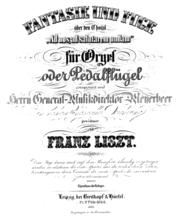
Fantasy and Fugue on the chorale Ad nos ad salutarem undam
Encyclopedia

Franz Liszt
Franz Liszt ; ), was a 19th-century Hungarian composer, pianist, conductor, and teacher.Liszt became renowned in Europe during the nineteenth century for his virtuosic skill as a pianist. He was said by his contemporaries to have been the most technically advanced pianist of his age...
in the winter of 1850 when he was in Weimar
Weimar
Weimar is a city in Germany famous for its cultural heritage. It is located in the federal state of Thuringia , north of the Thüringer Wald, east of Erfurt, and southwest of Halle and Leipzig. Its current population is approximately 65,000. The oldest record of the city dates from the year 899...
. It was dedicated to Giacomo Meyerbeer
Giacomo Meyerbeer
Giacomo Meyerbeer was a noted German opera composer, and the first great exponent of "grand opera." At his peak in the 1830s and 1840s, he was the most famous and successful composer of opera in Europe, yet he is rarely performed today.-Early years:He was born to a Jewish family in Tasdorf , near...
, who was the composer of the chorale "Ad nos, ad salutarem undam", which Meyerbeer first incorporated in the Act I of the opera Le prophète
Le prophète
Le prophète is an opera in five acts by Giacomo Meyerbeer. The French-language libretto was by Eugène Scribe.-Performance history:...
, and on which Liszt later based his organ composition. The Fantasy and Fugue was given its premiere on October 29, 1852. The revised version was premiered in the Merseburg Cathedral
Merseburg Cathedral
Merseburg Cathedral is a cathedral in Merseburg, Germany. Construction on the Gothic cathedral was begun by Bishop Thietmar of Merseburg in 1015. It was consecrated in 1021 in the presence of Henry II. The cathedral was renovated in the Renaissance style from 1510-17. It is considered an artistic...
on September 26, 1855, with Alexander Winterberger
Alexander Winterberger
thumb|Alexander Winterberger, by [[Sergey Lvovich Levitsky]]Alexander Winterberger was a German organist and composer...
performing. The whole work was published by Breitkopf & Härtel
Breitkopf & Härtel
Breitkopf & Härtel is the world's oldest music publishing house. The firm was founded in 1719 in Leipzig by Bernhard Christoph Breitkopf . The catalogue currently contains over 1000 composers, 8000 works and 15,000 music editions or books on music. The name "Härtel" was added when Gottfried...
in 1852, and the fugue was additionally published as the 4th piece of Liszt's operatic fantasy "Illustrations du Prophète" (S.414). A piano duet version by Liszt appeared during the same time (S.624).
Form
The piece consists of three sections:- Fantasy
- Adagio
- Fugue
The piece opens with the "Ad nos" theme and then turns quiet and contemplative. The theme returns and eventually a climax is reached. A second climactic passage follows, after which this section ends.
The Adagio serves as a development section, beginning quietly, the theme moving to major keys now from the minor keys of the preceding section. The piece brightens a bit in the latter half of this section.
The Fugue serves as the finale, but also, within the sonata-form, as the recapitulation and coda. Elements from the previous sections appear again. The piece ends with a triumphant coda, on full organ.
A typical performance lasts nearly half an hour.
Transcriptions

Ferruccio Busoni
Ferruccio Busoni was an Italian composer, pianist, editor, writer, piano and composition teacher, and conductor.-Biography:...
prepared a piano arrangement which was published in 1897 by Breitkopf & Härtel. Alan Walker, Liszt's biographer, said that it "represents one of the pinnacles of twentieth-century virtuosity." Liszt performed at least once his own piano transcription, of which Walter Bache
Walter Bache
Walter Bache was an English pianist and conductor noted for his championing the music of Franz Liszt and other music of the New German School in England. He studied privately with Liszt in Italy from 1863 to 1865, one of the few students allowed to do so, and continued to attend Liszt's master...
, his student, made an account in 1862. Liszt never seems to have notated such a version.

